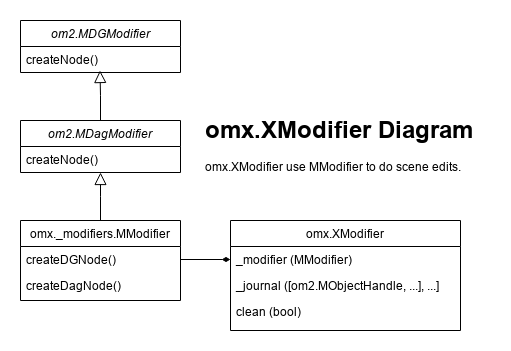Modifiers
AL_omx at it’s core, relies on Maya om2anim.MAnimCurveChange, om2.MDGModifier and om2.MDagModifier to modify the Maya scene data.
Just like Maya’s modifiers, after all the edit operations have been called, you need to call
modifier.doIt() at the correct time to execute these operations.

1. First, there are om2.MDGModifier and om2.MDagModifier in Maya native API.
The om2.MDagModifier inherits from om2.MDGModifier and comes with extra DAG creation and edit support,
so we can do pretty much everything with one single om2.MDagModifier instance,
except when it comes to the method createNode().
om2.MDagModifier overrides createNode() to only accept DAG node types, passing
it a DG node type will raise a TypeError.
To overcome this, we introduce AL.omx.utils._modifiers.MModifier, which derives from
om2.MDagModifier, but with explicit methods createDGNode() and createDagNode(). For
createDGNode(), we explicitly call om2.MDGModifier.create(self, typeName) instead.
2. Then we introduce AL.omx.XModifier, which owns a AL.omx.utils._modifiers.MModifier, as
shown in the graph above. AL_omx maintains a global list called _CURRENT_MODIFIER_LIST, which contains
a bunch of AL.omx.XModifier.
3. By default, AL.omx.XModifier has the immediate state turned off.
When you call AL.omx.newModifier(), it creates and pushes a non-immediate AL.omx.XModifier instance into _CURRENT_MODIFIER_LIST.
On the other hand, if you call AL.omx.currentModifier(), it gives you the last pushed AL.omx.XModifier from
_CURRENT_MODIFIER_LIST, if no modifier has ever created and pushed before, it will create and push an immediate AL.omx.XModifier
instance into _CURRENT_MODIFIER_LIST, then return it to you.
4. When a new Maya scene is created, or before a Maya scene is opened, or Maya quits,
the _CURRENT_MODIFIER_LIST will be cleared and emptied. This is ensured during the omx mpx command plug-in load/unload.
Tip
Use AL.omx.currentModifier() to retrieve an XModifier most of the time, as it has the advantage over the om2 modifier where you won’t need
to pass the modifier around as arguments.
Only call AL.omx.newModifier() when you need to organize your scene edits using different modifiers or manage the undo yourself.
XModifier Immediate Mode
If AL.omx.XModifier._immediate is True, whenever you call its method to edit Maya’s scene data, it will call
doIt() to apply the edit to the scene immediately. On the other hand, if AL.omx.XModifier._immediate is False, then
you’ll have to manually call AL.omx.doIt() or XModifier.doIt() to apply the edit.
This is the case except when it comes to node creation. You can not have a valid om2.MObject immediately when creating a node using a modifier. So regardless of the immediate state, it will always call doIt() automatically after node creation.
If you do not call AL.omx.newModifier() or manually create a AL.omx.XModifier(), and use creation or edit method from
AL.omx.XNode or AL.omx.XPlug, it will push an immediate omx.XModifier into the global list.
That is why in the script editor when you run omx scripts, it immediately reflects the edit in the Maya scene.
Note
Same as Maya’s modifiers, stacking operation and call doIt() at the end is of best performance.
The immediate AL.omx.XModifier does cost you performance.
Note
Calling AL.omx.doIt() will call all AL.omx.XModifier.doIt() with the global list, and clear the list.
If you only want to be more specific about applying edits from a certain modifier, use AL.omx.XModifier.doIt().
See also
- Undoability
Check out the undoability document to see how
AL.omx.XModifierfits into Maya’s undo & redo system.